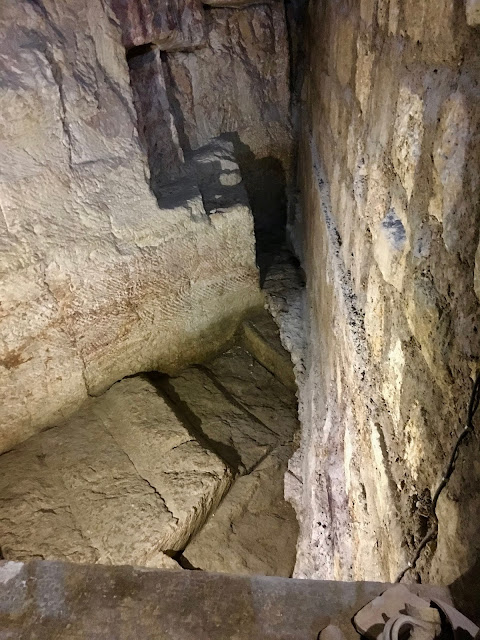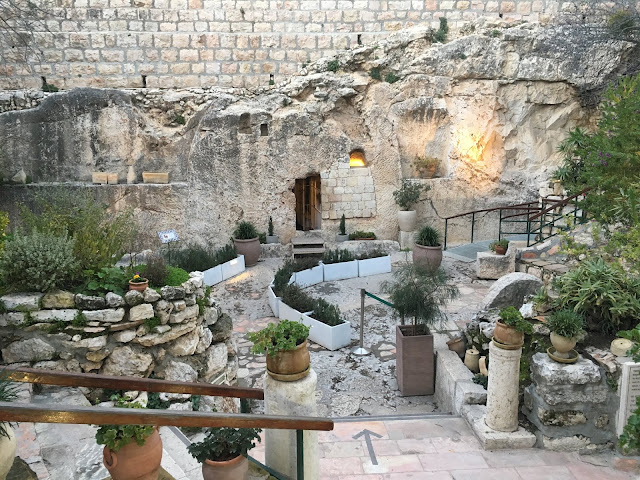For Christians, probably the most visited sites in Jerusalem are the Church of the Holy Sepulcher and (especially for Protestants) the Garden Tomb. Both are within a few minutes' walk from where we are living, so we have visited numerous times on our daily walks. We also joined an excellent tour led by an Armenian scholar whose family has had a long history with the Church of the Holy Sepulchre. The church has a rather inauspicious entrance, squeezed between other buildings in the Old City; however, one can see its domes much better from a higher vantage point. The small plaza outside the main door is usually crowded with people.
The church is built over two major shrines -- Calvary or Golgotha, the place of Jesus' crucifixion, and Jesus' empty tomb. It is the shared property of several religious groups, amongst them are the Roman Catholic, Greek Orthodox, Armenian Apostolic, Coptic Orthodox, Syrian Orthodox, and Ethiopian Orthodox. There are many stories of altercations between the groups, and about the difficulties in accomplishing anything because of the need for everyone to be in agreement. Most famous of these is one about the "immoveable ladder" which has been in this exact position (even though it has had to be replaced because of deterioration) since before 1852.
No Protestant denomination has a presence in this church, which may be why Protestant groups often prefer to visit the Garden Tomb. Below is a diagram of the church structure and shows its many chapels and other areas.
The first place you see on entering the church is pictured below. It is designated by (fairly recent, I'm told) tradition as the anointing stone upon which Jesus' body was laid to be prepared for burial. Usually someone is kneeling and kissing it, or placing some object on it, or praying with hands outstretched touching it.
The areas of the church designated traditionally as the hill of Calvary or Golgotha are upstairs and in a couple of different locations, depending on the denomination that maintains the area. Sometimes groups move from one location to another in the church, having services with candles, chanting, and readings along the way. We've followed along behind such groups occasion.
This ceiling is made from mosaics. From a distance it looks like paintings. Very beautiful!
The site of the burial is enclosed within a 19th century shrine called the Edicule. People line up and wait for sometimes 1-2 hours to enter for a few seconds of viewing or contemplation.
Below is a view from above the Edicule and of the waiting line. The entrance is on the right side.
.
We entered the excavation area through this locked door with a grate in it.
As you can see, it's quite deep under the present church.
The area is now used as a storage room for various things used in the church, but one thing of particular interest was this picture of a boat on a stone, presumed to have been drawn by a pilgrim to the site sometime in the first part of the 4th century A.D. The inscription has been translated from the Latin to read "Lord, we shall go." Numerous scholarly articles have been written about this piece.
Not far outside the current Old City walls is the Garden Tomb. unearthed in 1867. Many Christian pilgrims like to visit this site because it is more evocative of what is usually pictured or imagined as the burial place of Jesus, though scholars have dismissed claims of its authenticity. That being said, the place is peaceful and beautifully maintained. When visiting, one often sees groups of visitors having prayer services in the outdoor "chapels" set in the beautifully landscaped grounds.
Adjacent to the site, you can look at what has been suggested to be Golgotha, the Place of the Skull. If your imagination is good, you may see the eyesocktets of a skull in the cliff.
This past Sunday was Easter, and we were able to attend a service at the Garden Tomb. The day was very cold for this time of year, with occasional rain and blowing wind, but we still found it moving to be celebrating the resurrection somewhere close by where it actually happened. Here are some photos taken at that time.












































No comments:
Post a Comment